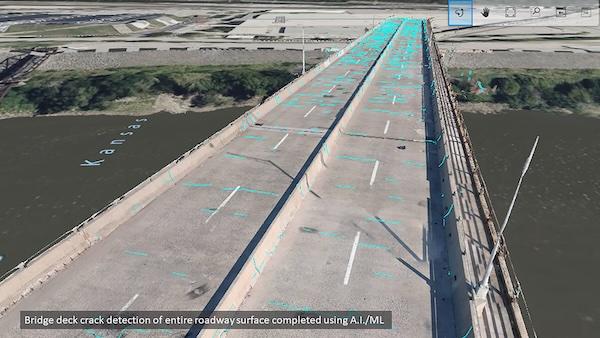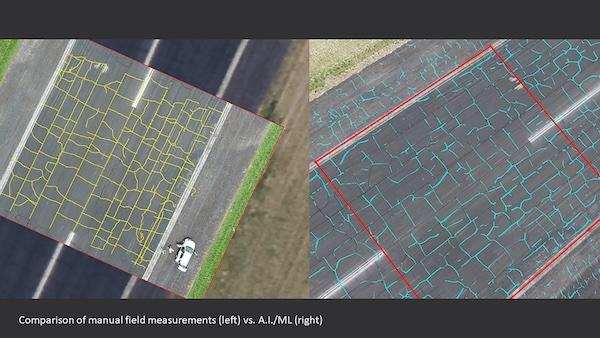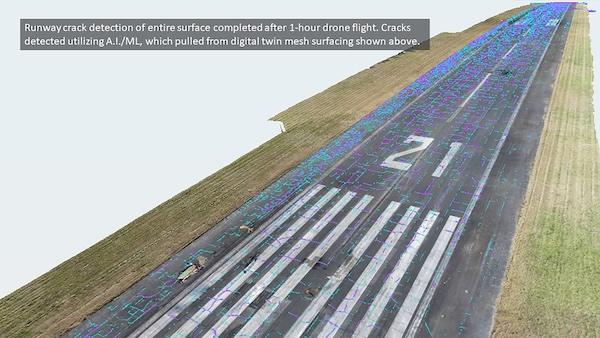Benesch Harnesses the Power of AI, Machine Learning, and Infrastructure Digital Twins to Industrialize Pavement Management
September 2nd, 2024 by Aude Camus
Leveraging Bentley Infrastructure Cloud and iTwin Technology Streamlines Workflows and Facilitates Data-centricity to Save over 75% of Manual Field Work
Project Summary
Organization: Benesch
Solution: Surveying and Monitoring
Location: United States
Project Objectives:
- To streamline and automate pavement crack detection processes.
- To leverage AI/ML and digital twins for an intelligent, data-centric application to pavement assessment.
Project Playbook: iTwin, iTwin Capture
Fast Facts
- Traditional pavement management processes lack efficiency and comprehensiveness, failing to maximize asset value.
- Benesch explored integrating AI/ML and digital twins for a more data-centric, automated pavement detection workflow.
- Leveraging Bentley’s iTwin applications with AI/ML technologies, Benesch piloted a ground-breaking digital solution.
ROI
- The pavement crack detector technology saved 75% in onsite manual data collection.
- Benesch expects to save an estimated USD 144,000 when inspecting 100 future airports.
- The data-centric approach will save 99% of time for CAD users to digitize linework.
Pushing Technology Boundaries for Pavement Assessment Workflows
Most civil infrastructure assets—including bridges, transport networks, and airport runways—include pavement, requiring crack detection survey and maintenance to ensure the safety and longevity of these structures. However, current traditional pavement assessment practices and data collection methods are costly, time consuming, and result in shutdowns that negatively impact infrastructure owner-operators, as well as the public. “Our clients struggle with the amount of time that it takes consultants to close their assets down, and current methods for collecting cracking and joint data take too long,” said Bret Tremblay, technical manager at Benesch, a multidiscipline engineering firm offering services across a broad range of civil infrastructure markets. In addition, the on-site inspections and analyses would not be conducted for the entire pavement, but rather across sample sections, providing general insight into existing area damage and a projected average for defects throughout the rest of the asset. While this approach opens the door to quantity overruns and change orders, it has become standard industry practice.

Courtesy 1: Benesch explored integrating AI/ML and digital twins for a more data-centric, automated pavement detection workflow. Image courtesy of Benesch.
Callout Quote: “Through our successful partnership with Bentley, Benesch has produced an extraordinary and highly automated pavement crack data collection workflow that will change the way we analyze and manage pavement assets for our clients.” – Bret Tremblay, Technical Manager, Benesch.
With no available solutions to resolve these issues, Benesch initiated a research and development project using advanced technology applications to improve data collection efficiencies, streamline pavement detection workflows, and eliminate survey-related closures of an airport runway. Their vision involved expanding their infrastructure digital twin capabilities using artificial intelligence (AI) and machine learning (ML) to not only meet the needs of their own customers, but also, eventually, the entire industry, developing a smart digital pavement detection application. “Once we had a vision for what the technology would need to do to meet the needs of our customers, we began collecting data from three active project sites in the United States,” said Tremblay. This data would be used to test their digital pavement crack detector and advance its capabilities to cover more ground in less time, as well as capture more data about the surveyed areas faster, improving community safety both locally and globally.
Bridging the Digital Data Gap
“The traditional crack detection method, or what is known as a boots-on-the-ground approach, requires inspectors to walk the pavement to take photos while making handwritten notations and taking measurements with a tape wheel,” said Tremblay. This is a laborious method where records end up being scanned and include hand sketches that cannot be easily utilized without time-consuming digitization processes. Also, because it is a manual on-site inspection, there can be logistical complications due to shutdowns, resulting in added costs that are passed on to the client. While the advent of drone technology to capture high-resolution aerial orthophotos offers a potential solution, enabling views of cracks directly on images and saving time during digitization, it fails to provide a holistic solution. As existing pavement sections continue to deteriorate and demand for pavement inspection and maintenance continues to rise, this digital approach falls short—and assets are being used beyond their design life.

Courtesy 2: The pavement crack detector technology saved 75% in onsite manual data collection. Image courtesy of Benesch.
The drone inspections digitally capture the data and improve efficiency by eliminating the conversion of the scanned photos; however, there remains a data utilization gap preventing a fully data-centric digital solution. “It does not allow practitioners to analyze or classify cracks based on a condition assessment without the accompanying boots-on-the-ground inspection activities. We saw our customers struggle with this capability gap,” said Tremblay. To bridge the digital data gap, Benesch sought to explore how to better utilize and integrate technologies to streamline the entire crack detection process and facilitate a data-centric approach. They wanted to develop a digital pavement crack detector where digital data could be made available in real time to the right person at the right time for more timely, informed decision-making, leading to better outcomes that ensure structural integrity. To create their ground-breaking pavement assessment application, Benesch realized that they needed an infrastructure digital twin solution capable of harnessing the power of AI and ML technology.
Leveraging AI/ML with iTwin Applications
Leveraging their partnership with Bentley, Benesch explored the integration of AI and ML into their field data collection workflows, specifically targeting crack detection in pavement. “Extensive research led us to Bentley and their early adopter programs; we were confident that harnessing Bentley’s AI and ML capabilities would allow us to develop technology workflows that deliver significant efficiencies and enhance the quality of field data collected,” said Tremblay. Benesch selected Bentley’s iTwin Capture and iTwin Experience to pilot their digital innovation, creating digital twins of their three selected sites and developing workflows that could harness the power of AI and ML to streamline the entire crack detection process, from field data collection to analysis.

Courtesy 3: The data-centric approach and smart technology solution will save 99% of time for CAD users to digitize linework. Image courtesy of Benesch.
The first step in developing the digital twin was to fly the entirety of each project site using an automated drone flight plan, transfer the drone-captured images to an online portal, and run them through the AI/ML detection software to extract and analyze data on the detected cracks. “As with other AI/ML technologies, the more data that is fed to the detector, the smarter it gets—not only in terms of detecting cracks, but also separating out joint lines from cracks,” said Tremblay. The AI/ML-based pavement crack detector automated the digitization of crack linework data and fed the data through the digital twin model, providing a visual, real-time, and reliable analysis of the crack data from the project sites. Leveraging Bentley’s iTwin applications provided Benesch with the ability to augment the digital inspection, uniquely identifying each crack by tagging the condition notes directly in the digital twin model, then remotely reviewing the condition of the entire asset. The digital defect information from the model can be subsequently and seamlessly exported into plan sheets and other platforms where asset management teams can prioritize repairs and maintenance.
Intelligent Data-driven Solution to Become Industry Game Changer
The digital detector has been put to the test on multiple projects and thus far has yielded excellent results. Compared to traditional manual methods, the intelligent, data-driven application reduces risks and delivers efficiencies, increasing safety in field data collection, reducing traffic shifts and airport operation closures, and minimizing human error through automated workflows. Over the course of the three projects, field time was reduced by an estimated 75%, along with a 75% reduction in vehicle traffic and airport runway closures. “By streamlining every step of the process, inspectors can cover more ground in less time, thereby tackling more projects at a lower cost to owners,” said Tremblay. Benesch estimates that over 1,000 hours will be saved across 100 future airport inspections, equivalent to saving approximately USD 144,000. The results also showed that the data-centric approach will save 99% of time for CAD users to digitize linework and send to owner-operators.
Before this project, there was no solution for automatically digitizing crack data after field inspections were completed. Working in an immersive digital twin environment fueled by AI/ML facilitated digital data-centric workflows that shifted asset management perspectives from a fragmented approach to a single source of truth, providing an understanding of the entire structure for better decision making. Over time, as Benesch broadly implements this technology for their customers, they expect to see optimized maintenance of critical transportation infrastructure, leading to a safer environment for everyone. The ground-breaking combination of AI/ML and digital twins for pavement management is a solution that not only benefits Benesch and their customers, but will also benefit the entire architecture, engineer, and construction industry. “This could be a game-changer for inspection data collection in the AEC industry,” said Tremblay.
Like this:
Like Loading...
This entry was posted
on Monday, September 2nd, 2024 at 12:30 am.
You can follow any responses to this entry through the RSS 2.0 feed.
Both comments and pings are currently closed.